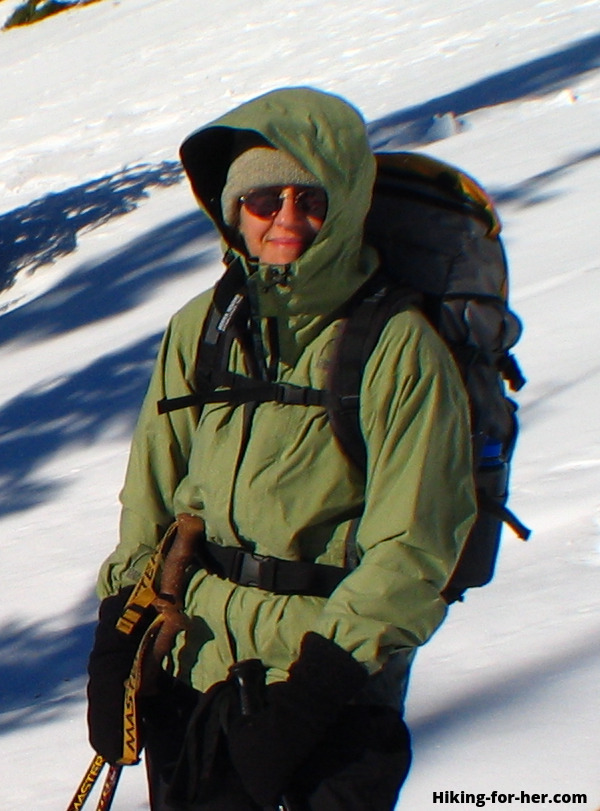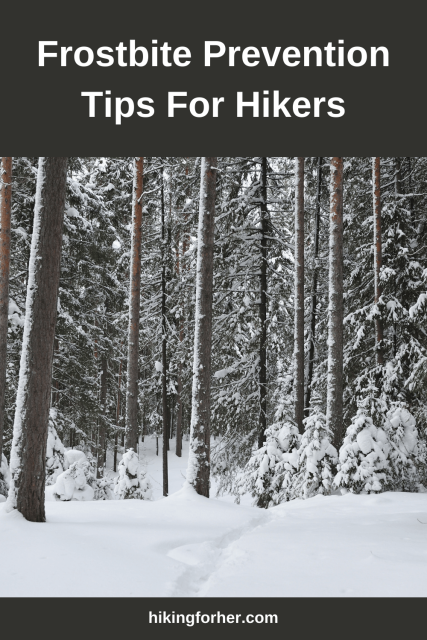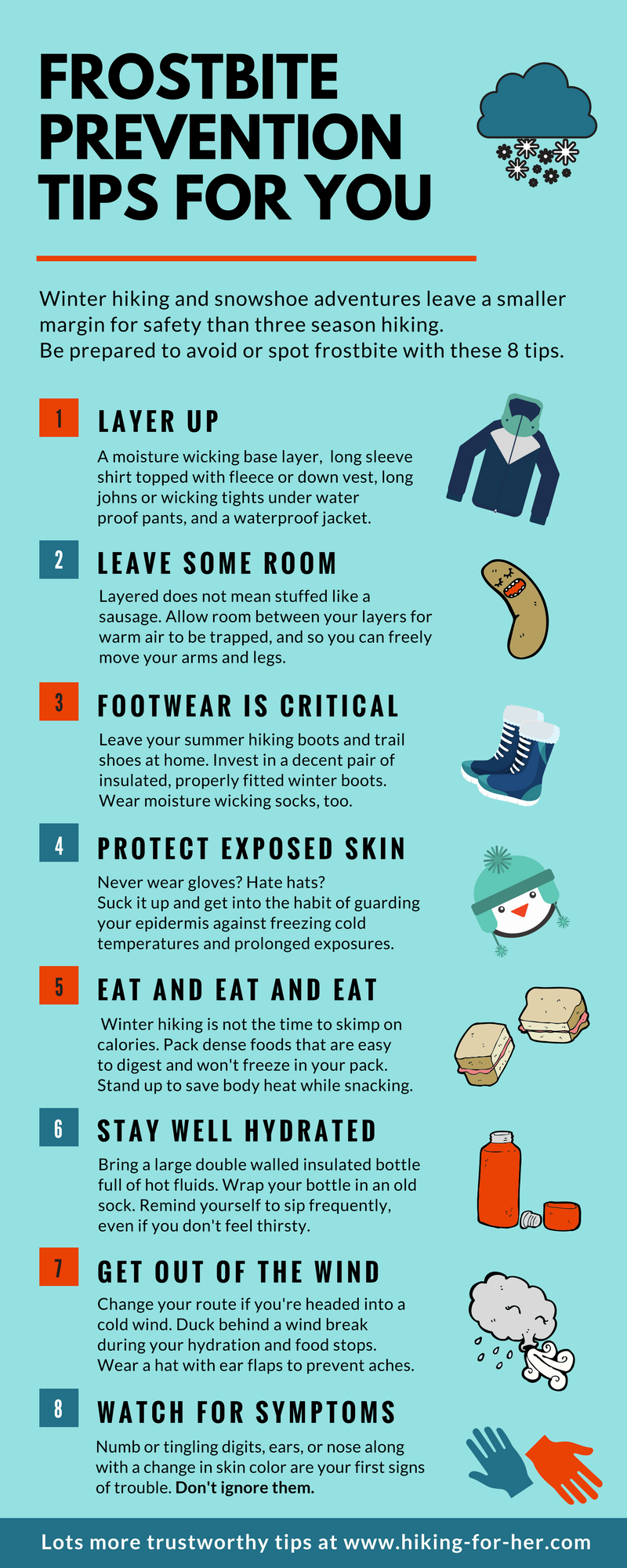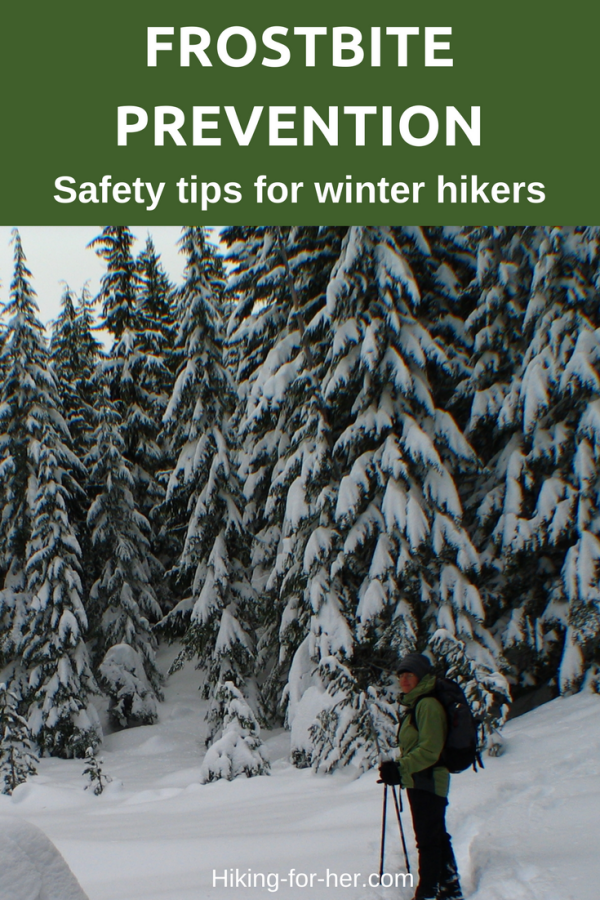
Frostbite Prevention Tips:
Best Ways To Avoid Trouble
On Winter Hikes
By Diane Spicer
Any hiker who ventures forth in cold weather needs the best frostbite prevention tips to keep herself safe.
These Hiking For Her frostbite tips also will keep you out of trouble when you are kept out in the cold due to storm damage, natural disasters, interrupted transportation, and other events beyond your control.
And they work for routine day hikes in winter, too.
What is this thing called frostbite?
Extremely cold temperatures damage the tissues of your body in exposed areas, which means dressing appropriately for the weather is a top priority before you set foot on the trail (or break trail, in snowshoeing).
- Some tips on that in a moment.
There are other words used for tissue damage due to below freezing temperatures:
- frostnip (superficial first degree frostbite)
- chilblains (swelling)
- hypothermia
On this page, let's stick to frostbite, defined as reduced blood flow (with its associated body heat) to vulnerable body parts.
- Think fingers and toes. Ears and nose.
Wet skin is dangerous
in cold conditions
Also be aware that prolonged exposure to cold temperatures, especially when skin becomes wet, can land you in trouble.
This is a likely scenario for a hiker who sets out in the morning for a winter hike in near freezing temperatures, but gets caught out in nasty weather conditions.
Cold wind and higher altitudes will also set you up for problems unless you take appropriate precautions.
It's a matter of degree
As with thermal burns, frostbite is categorized by degrees, to indicate the depth of tissue which has been damaged.
- First and second degree frostbite is confined to upper layers of the skin, with little to no permanent damage as a result.
- Third and fourth degree indicates deeper injuries with expected tissue loss and deficits.
- Some clinicians use "grades", rather than degrees.
Obviously, our aim on this page is to prevent, or to spot and reverse, frostbite before it advances into deeper tissue layers.
For a more clinical approach to all cold weather injuries, this book does a good job.
Frostbite prevention tips:
what trouble looks & feels like
Frostbite sounds painful, doesn't it?
- So it's ironic that it may not hurt right away!
Instead, watch for changes in sensation as you grasp your hiking poles or dig something out of your backpack:
- tingling, which is easy to ignore but please don't
- pins and needles [similar to when your foot "falls asleep"]
- numbness, which shows up as clumsiness when you try to grasp your water bottle
- a stiffness to your skin
Heed your body's feedback & take action
All of these are symptoms: subjective feedback from your body that only you will notice.
Your body is telling you that the areas experiencing these symptoms are being starved of oxygenated blood flow, and they don't like it!
- If a body part becomes painful, you've waited a bit too long. Cells are freezing and announcing their demise to your pain receptors.
Another way to notice frostbite creeping up on someone: extremely red skin (light skinned hikers) or darkened skin (with darker skin tones) on face, neck and ears.
Alternatively, the skin may appear white or gray as frostbite advances.
These are signs (objective information, like a big red stop sign) that the blood flow to the periphery of the body is being diverted to the core, in order to preserve the functioning of vital body systems.
- You won't be able to notice these signs in yourself if they occur on your head, but you can ask your hiking partner for feedback.
- And you will notice the skin tone changes in your trail buddies worsen over time as the cold exposure continues.
These photos of frostbite will help you spot trouble.
 Sun is shining, but bundle up and guard your skin from cold temperatures: wool hat plus hood, waterproof glove covers, and a clothing layer system
Sun is shining, but bundle up and guard your skin from cold temperatures: wool hat plus hood, waterproof glove covers, and a clothing layer system
Frostbite prevention tips
for outdoorsy folks
None of these frostbite prevention tips is more important than the others.
Use every one of them to keep yourself safe during cold, wet, windy, higher elevation outdoor time.
Frostbite prevention tips for you
If you've resisted the hiking mantra of "layer up", change your ways!
- Tips for building a layering system are here.
Layering doesn't mean wearing tight, constricting clothing, however. Be sure there is adequate room for full movement.
- If you feel trapped in your clothing, your blood flow will be restricted.
Make sure your outer layer is waterproof.
- If you're going to do cold weather activities in wet climates (like the Pacific NW where I hang out), you must invest in waterproof jackets and pants. No way around it!
Keep moving. Your skeletal muscle contractions keep blood circulating, and generate heat trapped in your clothing layers.
- Don't sit down to eat or drink.
- Don't allow your body temperature to be sucked out of your body by contact with cold, wet, or snowy surfaces.
Pay special attention to your footwear.
The boots you wear for three season hiking are not going to cut it for winter hiking or snowshoeing.
See my suggestions here. And be sure they aren't too tight or press on areas of your feet.
Wear absorbent socks to wick perspiration away from your skin.
- If you are hiking with someone who insists that trail shoes are "just fine" for winter outings, find a different trail buddy.
- Bad things happen to cold, wet feet in trail shoes.
More frostbite prevention tips
to heed
Don't allow yourself to become hungry or dehydrated.
- You need the calories and water to keep your core temperature humming along, and your blood flow to continue to perfuse all of your tissues.
- You also need to carry more dense, calorie rich food for your winter hiking and snowshoeing outings.
- Snack often!
Not much of a hat or glove wearer? Suck it up!
Protect your skin from cold injury from the first moment of your cold weather hike.
Be watchful
Keep an eye on yourself and everyone else in your group.
You already know the signs and symptoms to watch for (see above).
Now I'm giving you permission to be nosy:
- Ask questions if someone is fumbling with their gear, or slows down and appears to be walking differently.
- Offer your extra layers (see Ten Essentials regarding extra clothing) to cover up necks, ears, face, fingers. Insist they be used, for the good of the group.
People who are most vulnerable to cold injuries include:
- babies
- older hikers (define older in whatever way you wish, but generally over 55 years of age)
- people with circulatory problems (diabetes, previous cold injuries, hypothyroidism)
- smokers and any caffeine or alcohol over-indulger
Summing it all up in one word
For frostbite, practice prevention, because the treatment is not anything you want to go through.
- Gangrene, loss of digits or limbs, permanent nerve damage - no thanks!
I sincerely hope you will take these frostbite prevention tips to heart, and make yourself as invulnerable to trouble as you can before you set out on your winter outdoor adventures.
Lots more cold weather hiking tips for you right here!
Let's all stay safe out there when Mother Nature gives us the cold shoulder :)
Home page > Best Hiking Tips >
Best Frostbite Prevention Tips For Hikers
|
I get emails all the time about what I wear, eat, carry and love to use on the trail. That's
why I provide affiliate links to you: the best gear that I use myself and have seen used by other hikers is instantly
available for your consideration, and the gear company sends a few
pennies per dollar to this reader-supported hiking website. There is no added cost to you! Everyone ends up a winner: Great gear for you, strong gear companies, and more free hiking tips for everyone. Thanks very much for your support. It's warmly and sincerely appreciated. It also helps send these hiking tips to all your virtual trail buddies around the globe. |
 |




